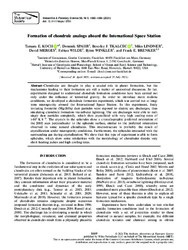Formation of chondrule analogs aboard the International Space Station
Spahr, Dominik
Merges, David
Wilde, Fabian
Winkler, Björn
DOI: https://doi.org/10.1111/maps.13731
Persistent URL: http://resolver.sub.uni-goettingen.de/purl?gldocs-11858/9896
Persistent URL: http://resolver.sub.uni-goettingen.de/purl?gldocs-11858/9896
Koch, Tamara E.; Spahr, Dominik; Tkalcec, Beverley J.; Lindner, Miles; Merges, David; Wilde, Fabian; Winkler, Björn; Brenker, Frank E., 2021: Formation of chondrule analogs aboard the International Space Station. In: Meteoritics & Planetary Science, Band 56, 9: 1669 - 1684, DOI: 10.1111/maps.13731.
 |
Dokument öffnen: |
Chondrules are thought to play a crucial role in planet formation, but the mechanisms leading to their formation are still a matter of unresolved discussion. So far, experiments designed to understand chondrule formation conditions have been carried out only under the influence of terrestrial gravity. In order to introduce more realistic conditions, we developed a chondrule formation experiment, which was carried out at long‐term microgravity aboard the International Space Station. In this experiment, freely levitating forsterite (Mg2SiO4) dust particles were exposed to electric arc discharges, thus simulating chondrule formation via nebular lightning. The arc discharges were able to melt single dust particles completely, which then crystallized with very high cooling rates of >105 K h−1. The crystals in the spherules show a crystallographic preferred orientation of the [010] axes perpendicular to the spherule surface, similar to the preferred orientation observed in some natural chondrules. This microstructure is probably the result of crystallization under microgravity conditions. Furthermore, the spherules interacted with the surrounding gas during crystallization. We show that this type of experiment is able to form spherules, which show some similarities with the morphology of chondrules despite very short heating pulses and high cooling rates.
Statistik:
ZugriffsstatistikSammlung:
This is an open access article under the terms of the Creative Commons Attribution License, which permits use, distribution and reproduction in any medium, provided the original work is properly cited.

